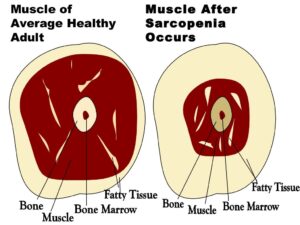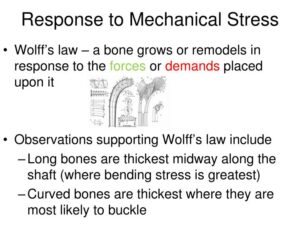Lifting weights, or resistance training, is hard work. It can take some time and dedication to maintain a good routine. Often, it isn’t considered a method of exercise for various reasons. Some excuses I’ve heard from my clients at BTF is that they don’t want to “bulk”, they are “too old” to lift weights, or they just “prefer doing cardio”. Let’s talk about some reasons why you should add in, or continue your resistance training routine.
 As we age, we fall victim to a process called sarcopenia. Sarcopenia is the loss of muscle mass, strength and function as we age. It has been shown that individuals can lose as much as 30-50% of their muscle mass and function by the age of 80, usually with the process starting around the age of 30-40. There are multiple factors that contribute to this process, with one of the big ones that we experience today being a sedentary lifestyle. Some big concerns we see with sarcopenia is decreased mobility and independence, decreased bone density, and increased risk of falling. Why is this all important though, aging is inevitable right? There is plenty we can do to slow that process and continue our independence into our later years of life.
As we age, we fall victim to a process called sarcopenia. Sarcopenia is the loss of muscle mass, strength and function as we age. It has been shown that individuals can lose as much as 30-50% of their muscle mass and function by the age of 80, usually with the process starting around the age of 30-40. There are multiple factors that contribute to this process, with one of the big ones that we experience today being a sedentary lifestyle. Some big concerns we see with sarcopenia is decreased mobility and independence, decreased bone density, and increased risk of falling. Why is this all important though, aging is inevitable right? There is plenty we can do to slow that process and continue our independence into our later years of life.
 Muscles are composed of different fiber types called type I and type II fibers. Type II gets broken down even further but for the sake of keeping it easy today we’ll stick with type I and type II. Type I fibers are our slow twitch fibers that are known as our endurance muscles. They work aerobically and are generally associated with activities like walking. Type II fibers are our fast twitch fibers that are known as our power muscles. They work anaerobically and are generally associated with activities involving intense strain on our muscles such as sprinting and resistance training.
Muscles are composed of different fiber types called type I and type II fibers. Type II gets broken down even further but for the sake of keeping it easy today we’ll stick with type I and type II. Type I fibers are our slow twitch fibers that are known as our endurance muscles. They work aerobically and are generally associated with activities like walking. Type II fibers are our fast twitch fibers that are known as our power muscles. They work anaerobically and are generally associated with activities involving intense strain on our muscles such as sprinting and resistance training.
A recent study has shown that with aging, type I fibers are less affected than the type II fibers. The type II fibers are the ones that are shown to have a decrease in size and a decrease in contractile  function. So, a majority of that muscle loss we experience with age comes from the type II fibers. Knowing that, we can proactively try to mitigate those losses by training to keep those muscle fiber types active. One of the easy ways to start with that is including resistance training into your routine. As you age, it can feel harder to build up your muscle with resistance training. Creating the habit of resistance training when you’re younger can be carried with you your entire life. But, it is never too late to start! Our skeletal muscle is known to have very good plasticity, meaning that it can adapt very well. It has been shown that even up to 80 years old, with the right type of training, individuals can show an increase in strength gains.
function. So, a majority of that muscle loss we experience with age comes from the type II fibers. Knowing that, we can proactively try to mitigate those losses by training to keep those muscle fiber types active. One of the easy ways to start with that is including resistance training into your routine. As you age, it can feel harder to build up your muscle with resistance training. Creating the habit of resistance training when you’re younger can be carried with you your entire life. But, it is never too late to start! Our skeletal muscle is known to have very good plasticity, meaning that it can adapt very well. It has been shown that even up to 80 years old, with the right type of training, individuals can show an increase in strength gains.
Keeping your physical activity and strength level up as you age is also beneficial for keeping your mobility and independence. Major concerns with age are losing your independence and having the risk of falling. As we know, when we lift weights or perform any sort of resistance training, our muscles respond by increasing in strength. Similar processes happen at the level of the bone as well. When we load our muscles we also load our bones, and this  is a good thing. As Wolff’s Law states, bones will adapt to the stresses placed on them. So, if you load up your muscles and bones by lifting weights not only will you see the effects in your muscle strength, but your bones will also respond by building up and becoming strong in those areas as well. The more you train this way, the better chances of keeping your mobility and independence later in life.
is a good thing. As Wolff’s Law states, bones will adapt to the stresses placed on them. So, if you load up your muscles and bones by lifting weights not only will you see the effects in your muscle strength, but your bones will also respond by building up and becoming strong in those areas as well. The more you train this way, the better chances of keeping your mobility and independence later in life.
 Now, as you’ve read through this article, it may seem as if it is targeted at the older population considering we’ve addressed a lot of their concerns. And yes, it is important for them to understand the processes that happen with age. However, the younger you can start to incorporate these changes, the better off your health will be as you reach these older ages where these effects start to take place, and you will be better prepared to continue on with these preventative measures. It is always best to start healthy habits earlier on. So, let’s all go pick up some weights, not to bulk (unless that is your goal), but to start the journey of a healthier lifestyle leading to better longevity.
Now, as you’ve read through this article, it may seem as if it is targeted at the older population considering we’ve addressed a lot of their concerns. And yes, it is important for them to understand the processes that happen with age. However, the younger you can start to incorporate these changes, the better off your health will be as you reach these older ages where these effects start to take place, and you will be better prepared to continue on with these preventative measures. It is always best to start healthy habits earlier on. So, let’s all go pick up some weights, not to bulk (unless that is your goal), but to start the journey of a healthier lifestyle leading to better longevity.
If you would like professional guidance on how to perform resistance training correctly, please contact us at Back to Function. One of our highly skilled doctors can guide you safely and effectively on the road to feel, recover and perform better. Please call 310-534-1900 or email info@backtofunction.com to schedule your assessment today!
References:
Grosicki, G. J., Zepeda, C. S., & Sundberg, C. W. (2022). Single muscle fibre contractile function with ageing. The Journal of Physiology. https://doi.org/10.1113/jp282298
McCormick, R., & Vasilaki, A. (2018). Age-related changes in skeletal muscle: Changes to life-style as a therapy. Biogerontology, 19(6), 519–536. https://doi.org/10.1007/s10522-018-9775-3
Siparsky, P. N., Kirkendall, D. T., & Garret Jr., W. E. (2014). Muscle Changes in Aging. Sports Health, 6(1), 36–40.



